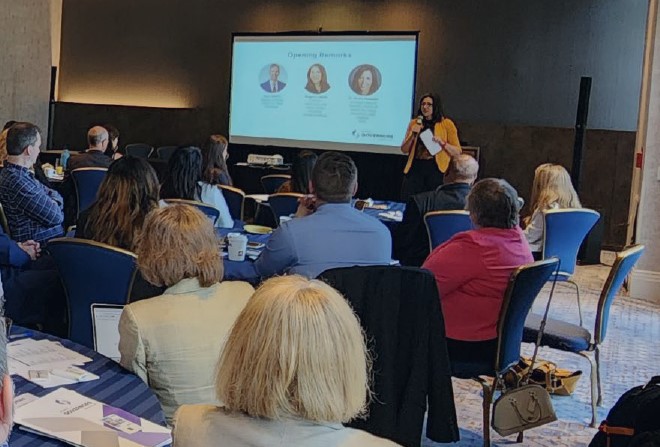“We know we have a housing accessibility and affordability crisis across America.”
Addressing the 2024 NGA Housing Policy Advisors Institute, Governor Glenn Youngkin underlined the severity of the housing shortage impacting communities in every state.
Governors recognize how closely workforce and economic goals are connected to housing availability. As Governor Youngkin explained: “Our approach is rested in a basic truth that if we want to grow economically and be the unabashed leader in opportunity, we need to create jobs; we need to train the talent to take those jobs; and, on top of that, we need to make sure that people have an incredible place to live. It takes all three of these contributing factors to drive real opportunity and unabashed growth for not just an economy, but for those who live in a state. When we link together jobs, talent, and livability, we want to make sure that we’re moving all of them at the same time.”

That understanding is the centerpiece for Governor Youngkin’s Workforce Housing Investment Program. Unveiled in November, the initiative aims to invest $75 million over five years with the potential to catalyze $750 million and build 5,000 units of workforce housing in conjunction with economic development projects. Governor Youngkin reinforced the initiative through an Executive Order formally tying economic development to workforce housing supply.
“At the front of it is a requirement that for localities to apply for state support for site development funding, [they] now have to have a housing plan,” he explained. “They have to have a plan on how they are going to facilitate and support [housing construction], through permitting and zoning and other means at their disposal. That is a big step that now marries together, as opposed to places in sequence, the idea of developing affordable workforce housing at the same time as developing an economically ready site or awarding an economic incentive package to recruit a company.”
Through the program, Virginia Housing will provide loans, loan subsidies, and grants up to $3 million to localities and nonprofits to develop housing for workers earning 80-120 percent of area median income, or up to 150 percent in rural areas.
The approach is designed to attract both job creators and job seekers. “People decide where they want to live every single day,” Governor Youngkin stated. “In those decisions, they incorporate the factors of life and opportunity and livability. If people don’t see opportunity, they will move and find it. if you are net exporting more people than move into your state, you make it very difficult for companies to bet on your state – to have companies say, ‘Hey, we’re gonna come and create jobs.’”
Governor Youngkin listed other strategies he’s pursuing to speed housing construction and reduce costs:
- Streamlining and adding transparency to state-level permitting: “We’ve now cut the time it takes to get a water permit in Virginia by 70%. That is an immediate bottom line to affordability in housing. This has been a big step for us, and we are working to bring that same level of transparency to localities. If they could just go faster, it would change the game.”
- Updating building codes: “We have focused on our building codes to bring down the overall construction cost of a new home by $24,000 per unit. This was a particularly concentrated effort. What can we do to bring in best practices so that we can bring down construction costs and not inflate them?”
- Establishing a Wetland and Stream Replacement Fund: “That provides a great way to trade wetland credits so that we can help developers get the credits they need so that they can build.”
These and other supply-side strategies are critical to meet Virginia’s target of adding 30,000 new housing units per year to keep pace with the commonwealth’s 23,000-person yearly net population growth.
“We now have the ability to offer to Virginians, or people who might want to move here: Not only can you get a great job, but there’s affordable and accessible workforce housing that would give you a great place for this next chapter in your life,” Governor Youngkin concluded.
“I’m looking forward to having people come to Virginia, or Virginians find new jobs in new areas, that allow them to not just have a great job, but experience the American dream.”
Governors Take Action

Throughout the Institute event, state housing advisors shared updates on policies their Governors are pursuing to build more housing.
In a panel discussion, Virginia housing advisors, Office of Regulatory Management Director Reeve Bull and Department of Housing and Community Director Bryan Horn, expanded on Virginia’s progress. They were joined by Patrick Hulin, Deputy Policy Director for Connecticut Governor Ned Lamont; and Scott Glenn, Senior Advisor, Office of Hawaii Governor Josh Green.
Virginia
As Governor Youngkin pointed out, CNBC named Virginia its “top state for business” in 2024 – yet the commonwealth is “still behind on providing that last element, which is the opportunity for people to find an affordable, available and accessible place to live.”
Two of his policy advisors, Reeve Bull and Bryan Horn, shared details on Virginia’s success in using state-level incentives and permitting reforms to spur construction – and to model progress municipalities can adopt:
Department of Environmental Quality: A pilot program created a permanent dashboard tracking permit approval time for site development processes. This transparency reduced permit processing times by 70 percent, as noted by Governor Youngkin. Although the program only applies to permit processing under the jurisdiction of the state, state officials hope to use it as a model to partner with local governments to achieve similar efficiencies.
Department of Professional and Occupational Regulation: This agency streamlined licensing time for construction-related occupations, reducing the average amount of time to get a contractor license from 33 days to about 5 days.
Building code reforms: Every three years, Virginia’s Department of Housing and Community Development adopts updated building codes based on codes promulgated by the International Code Commission. Through extensive consultation with the public, home builders and other stakeholders, the Department works to identify building code amendments to simplify requirements for industrial, commercial and residential construction unrelated to health or safety regulations.
Reforms like these have saved Virginians an estimated $1.2 billion per year, or about $389 for each Virginia household.
Connecticut
Connecticut’s housing shortage is so acute, the state has resorted to bussing in workers from nearby states to build highway projects – also footing the bill for hotels because affordable workforce housing is not available.
As Deputy Policy Director Patrick Hulin explained, state officials have seen some progress breaking logjams through the Affordable Housing Land Use Appeals Procedure, which allows the override of local zoning restrictions for builders constructing projects in which at least 30% of units are designated affordable.
Governor Lamont’s administration is also pursuing more broad-based, holistic policies to work with municipalities to develop a variety of housing types.
Central to this approach is the Connecticut Municipal Redevelopment Authority (MRDA), which launched in July 2024. MRDA’s focus is to spur transit-oriented development, particularly new housing, in part through partnering with municipalities to develop housing growth zones. The program is opt-in and incentive-based – offering project funding for localities that meet specified requirements.
When announcing MRDA’s formation, Governor Lamont emphasized, “The availability of housing is directly connected to a healthy economy because businesses want to expand and add jobs in locations where they have access to a quality workforce, and workers want to live where they have access to jobs and transportation.”
Governor Lamont also launched the Head Start on Housing pilot program, a first-of-its-kind initiative in Connecticut and the nation that identifies young children who are enrolled in Head Start and whose families are experiencing homelessness and connects them with permanent housing support leverage federal vouchers. Launched in 2022, Governor Lamont announced its expansion in December 2024.
Hawai`i
More Native Hawai`ians live outside the state than in it. It’s a revealing statistic that underlines the severity of the Aloha State’s affordable housing shortage.
Senior Advisor Scott Glenn recounted how Governor Josh Green issued an Emergency Proclamation on housing in July 2023 that suspended a number of regulatory barriers, appointed a State Lead Housing Officer, Established a Build Beyond Barriers Working Group and authorized a variety of other actions to spur housing construction.
By January 2024, Governor Green highlighted in his State of the State address that the proclamation immediately approved “some 10,800 new units of low-income housing for struggling families” while the “Build Beyond Barriers Working Group has also begun to reform housing bureaucracy, and has approved or accelerated multiple new projects that will bring thousands of homes to teachers, nurses, firefighters, and working families across the state in the coming years.”
The Emergency Proclamation must be renewed every 60 days, allowing it to serve as “kind of Silicon Valley rapid iteration” test approach to assess the efficacy of various provisions. One set of those provisions suspended regulatory barriers for housing projects – including adaptive reuse projects in vacant commercial space in downtown Honolulu – on state- and county-owned land in Honolulu. Once developers, localities – and legislators – observed the success of these projects, it became easier to codify pro-development provisions into law.
As these provisions are adopted into law, they are removed from the Emergency Proclamation, demonstrating, as Glenn put it, how Governors can effectively use executive action to “reframe the conversation.”
Conclusion
To learn more about policies Governors are leading to generate affordable, accessible, available housing, check out these publications:
- Improving Housing Availability and Affordability
- Governors Share Bipartisan Solutions to Housing Shortage
- Governors Share Housing Solutions
- Governors Talking the Talk and Walking the Walk on Housing
Housing policy leaders from more than 20 states and territories, along with national housing policy experts, gathered in Chantilly, Virginia, December 5-6 for the 2024 Governors Housing Policy Advisors Institute.













